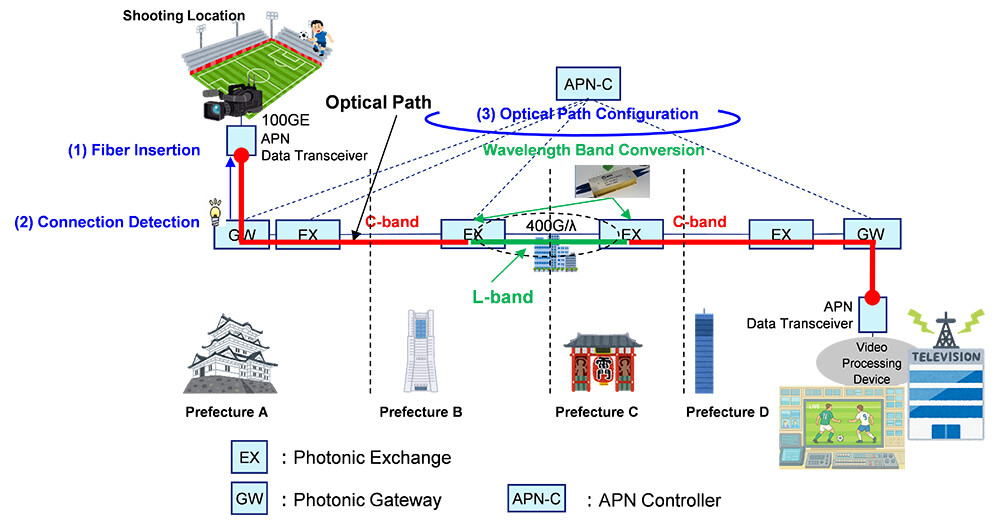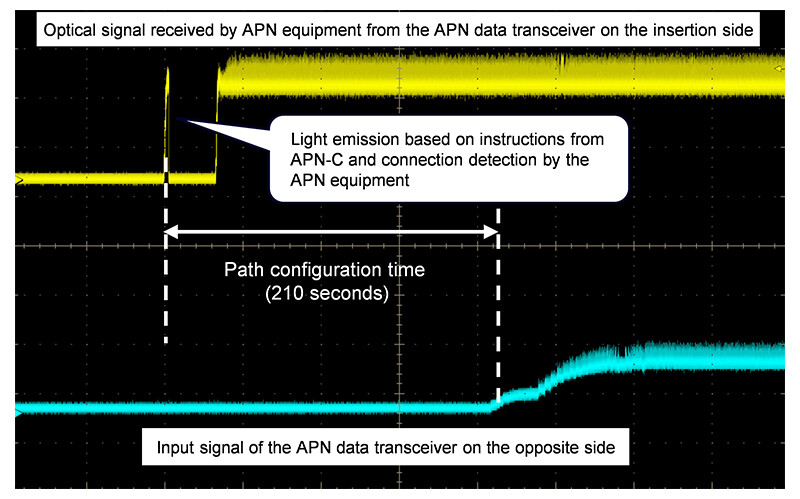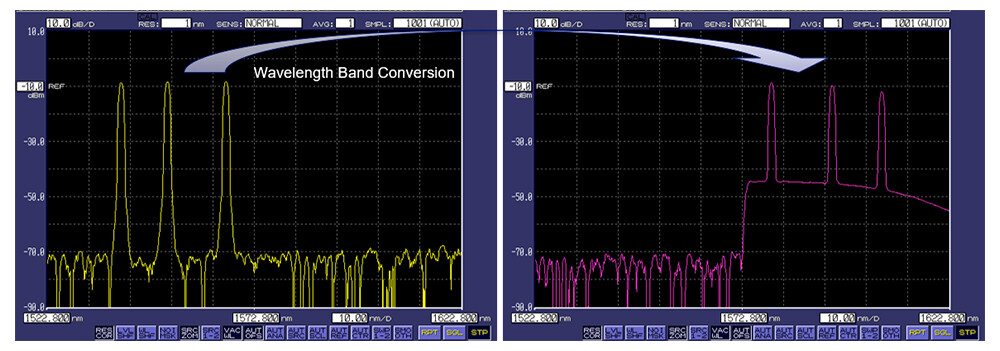Microsoft ends support for Internet Explorer on June 16, 2022.
We recommend using one of the browsers listed below.
- Microsoft Edge(Latest version)
- Mozilla Firefox(Latest version)
- Google Chrome(Latest version)
- Apple Safari(Latest version)
Please contact your browser provider for download and installation instructions.
April 25, 2025
NTT Corporation
Successful Demonstration of Basic Technology Enabling On-Demand, Timely APN Connections from Any Location in IOWN APN
News Highlights:
- We have successfully demonstrated a new connection method for the IOWN APN, enabling on-demand connections to the APN from any location, only when needed.
- One use case for on-demand APN connections is in broadcasting sports events. When games are held at various venues—both home and away—this technology allows camera and microphone equipment to be connected directly to the APN at the event location, enabling data transmission to the editing center without the need to dispatch personnel for network setup.
- We successfully demonstrated two basic technologies: a plug-and-play function that allows users to automatically connect equipment to the APN wherever and whenever needed, and a wavelength band conversion function that enables expansion of APN services using existing infrastructure.
TOKYO - April 25, 2025 - NTT Corporation (Headquarters: Chiyoda, Tokyo; President and CEO: Akira Shimada; hereinafter "NTT") has become the first in the world to successfully demonstrate a technology that enables on-demand provision of optical paths1 through the coordination of functional components that make up the IOWN2 All-Photonics Network (APN)3.
This achievement enables a new form of network connectivity envisioned for future APN services: simply by connecting a device to the APN, users can access high-capacity, low-latency optical paths on demand, from any location, and only when needed. Additionally, the technology allows for efficient use of existing network infrastructure in providing these optical paths.
Part of this technology is currently on display at the NTT Pavilion during Expo 2025 Osaka, Kansai, Japan.
Background
In the IOWN initiative, the IOWN APN leverages cutting-edge photonic technology to provide users with high-capacity, low-latency optical paths while minimizing power consumption. This is expected to enable a wide range of applications such as interactive live video streaming services, remote surgeries, and digital transformation (DX) in factories.
Since the launch of the IOWN APN 1.0 service by NTT EAST and NTT WEST in March 2023, NTT has been conducting various demonstrations that showcase the advantages of APN's high-capacity and low-latency characteristics. For example, under "IOWN APN Step 1 and Step 2 for Enterprise," NTT successfully established a stable and ultra-low-latency connection over approximately 3,000 km between Japan and Taiwan using APN technology4. Similarly, under "IOWN APN Step 1 and Step 2 for DCX (Data Center eXchange)," NTT is also advancing APN-based interconnection between data centers overseas.
NTT is now aiming for the next phase—IOWN APN Step 3—which envisions a new mode of APN connectivity where users at various locations can establish on-demand connections to the IOWN APN only when needed and for the required duration. One notable use case of Step 3 is remote video production, where, instead of producing content on-site, high-capacity and low-latency data transmission enables real-time video production in the cloud or at broadcasting stations. With on-demand connectivity enabled by IOWN APN Step 3, temporary high-capacity, low-latency links can be established between stadiums or event venues and production centers—making real-time video acquisition more efficient and flexible.
Challenges with Conventional Technology
Currently, when providing an optical path to users, it is necessary to dispatch technicians to the site to install data transceivers. In addition, technicians at both ends must coordinate with network operators to manually configure the optical path. To provide optical paths more promptly, it is essential to enable users to simply connect a pre-shipped data transceiver to the APN at their convenience—without the need for on-site technicians—and have the system automatically detect the connection and configure the optical path (see Figure 1).
Furthermore, to expand optical path coverage across a broader area, it is necessary to utilize various types of optical fibers already deployed in existing networks. Since the optimal wavelength band for optical transmission varies depending on the type of fiber, the system must also support wavelength band conversion to ensure the optical path uses the most suitable wavelength.
To address these challenges, NTT has been developing key technologies to support IOWN APN Step 3, including the Photonic Gateway (Ph-GW), Photonic Exchange (Ph-EX), and the APN Controller.
 Figure 1 Conventional Optical Path Setup vs. On-Demand Optical Path Setup
Figure 1 Conventional Optical Path Setup vs. On-Demand Optical Path Setup
Demonstration and Research Results
A demonstration experiment was conducted using the Photonic Gateway (Ph-GW), Photonic Exchange (Ph-EX), and APN Controller, simulating a remote video production use case. When data transceivers located at remote sites were connected to the APN, the system successfully detected the connection automatically using plug-and-play functionality, and established an on-demand optical path between the video capture site and the editing center. This successfully demonstrated the ability to provide optical paths as needed, whenever required.
To optimize optical path utilization within the APN during the demonstration, Ph-EX's wavelength band conversion functionality was applied. The signal was transmitted by converting it to an unused wavelength band within the transmission section, allowing more efficient use of network resources.
The following steps (Figure 2) were demonstrated as part of the on-demand optical path setup process:
- Fiber Insertion
An optical fiber is inserted into the data transceiver. - Connection Detection
Ph-GW detects that the optical fiber has been connected to the data transceiver and sends a request to the APN Controller to establish an on-demand optical path. - Optical Path Configuration
In response to the request from Ph-GW, the APN Controller sends path setup instructions to the Ph-GW, Ph-EX, and the data transceiver. These components are then controlled in real time to establish the optical path on demand.
 Figure 2 On-Demand Optical Path Setup — Demonstration Configuration and Procedure
Figure 2 On-Demand Optical Path Setup — Demonstration Configuration and Procedure
As part of the demonstration, these operations were carried out on a network composed of six APN devices. Following the insertion of the optical fiber, the APN device on the insertion side detected the optical signal from the data transceiver. Subsequently, the optical path was automatically established, and the data transceiver on the opposite side was able to detect the optical signal transmitted through the APN optical path successfully (Figure 3).
Furthermore, the network efficiently accommodated the optical path through the use of wavelength band conversion technology implemented in the Ph-EX (Figure 4).
 Figure 3 Demonstration Results of On-Demand Optical Path Setup Operation
Figure 3 Demonstration Results of On-Demand Optical Path Setup Operation
 Figure 4 Demonstration Results of Wavelength Band Conversion Function
Figure 4 Demonstration Results of Wavelength Band Conversion Function
Key Technical Highlights
- Photonic Gateway
Implements a plug-and-play feature that enables automatic optical path setup. When a data transceiver is connected, the APN Controller recognizes the transceiver's information and initiates the optical path configuration without manual intervention. - Photonic Exchange
In addition to the functions of conventional optical node systems, this component provides wavelength band conversion, utilizing NTT's proprietary optical device PPLN (Periodically Poled Lithium Niobate)5, which enables bulk conversion of transmission wavelength bands. - APN Controller
Establishes a protocol for providing on-demand optical paths and defines an extended interface specification based on open interface standards. This allows centralized control of diverse network equipment.
Outlook
This initiative successfully demonstrated the ability to automatically detect connection information upon connecting to the IOWN APN and to build an end-to-end optical path remotely, enabling on-demand collection of video content from remote locations. Additionally, we successfully conducted a demonstration of processing remote video content and distributing it to multiple sites.
The design of the end-to-end optical path leverages existing network infrastructure through advanced optical transmission technologies. Moreover, we applied failover technologies that enable rapid and cost-effective recovery in the event of network failures—ensuring highly reliable video delivery.
These achievements support the goals of IOWN APN Step 3, paving the way for new APN connection models that will allow a broader range of use cases to benefit from APN services more flexibly than ever before.
Looking ahead, based on the results of this proof-of-concept, we will advance the commercialization of various functions with the goal of launching APN Step 3 services in fiscal year 2028 and beyond. Furthermore, by leveraging the IOWN Global Forum, we will actively contribute to the Open APN Functional Architecture6 and promote both the validation and global adoption of APN technologies.
Additional Information
Some functions of the APN Controller used in the demonstration experiment leveraged outcomes obtained from the grant program (No. JPJ012368G60301) by National Institute of Information and Communications Technology (NICT), Japan.
[Glossary]
1Optical Path
An optical path is a route for an optical signal that connects a transmitter to a receiver. Each optical path consists of a route made up of optical fibers and optical node systems, with specified signal capacity and assigned wavelengths.
2IOWN
The IOWN (Innovative Optical and Wireless Network) is an initiative for networks and information processing infrastructure including terminals that can provide high-speed, high-capacity communication utilizing innovative technology focused on optics, as well as tremendous computational resources. For more details, please see:
■ What is the IOWN Initiative?
https://www.rd.ntt/e/iown/
3APN
The All-Photonics Network (APN) introduces photonics (optics) based technology to every aspect from the network to terminals. This enables far lower power consumption, higher quality, greater capacity, and less delay, all of which are difficult with current electronics based technology. For more details, please visit:
■ What is the All-Photonics Network?
https://www.rd.ntt/e/iown/0002.html
5PPLN
PPLN (Periodically Poled Lithium Niobate) is an optical device that enables bulk wavelength band conversion technology. It allows multiple wavelength signals contained within one wavelength band to be simultaneously converted to another wavelength band through optical processing. For more information, please visit:
Broadband Wavelength Conversion Technology Using PPLN | NTT R&D Website (Japanese)
Broadband Optical Parametric Amplification Relay Technology | NTT R&D Website (Japanese)
6Open APN Functional Architecture
Open APN Functional Architecture is an open photonics networking architecture proposed by the IOWN Global Forum. For more information, please visit:
Home - IOWN Global Forum
IOWN-GF-RD-Open_APN_Functional_Architecture-2.0.pdf
About NTT
NTT contributes to a sustainable society through the power of innovation. We are a leading global technology company providing services to consumers and businesses as a mobile operator, infrastructure, networks, applications, and consulting provider. Our offerings include digital business consulting, managed application services, workplace and cloud solutions, data center and edge computing, all supported by our deep global industry expertise. We are over $92B in revenue and 330,000 employees, with $3.6B in annual R&D investments. Our operations span across 80+ countries and regions, allowing us to serve clients in over 190 of them. We serve over 75% of Fortune Global 100 companies, thousands of other enterprise and government clients and millions of consumers.
Media contact
NTT Information Network Laboratory Group
Public Relations
Inquiry Form
Information is current as of the date of issue of the individual press release.
Please be advised that information may be outdated after that point.
NTT STORY
WEB media that thinks about the future with NTT










